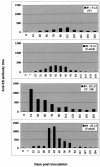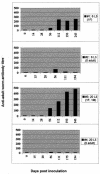Immunodiagnosis of experimental Parelaphostrongylus tenuis infection in elk
- PMID: 11858642
- PMCID: PMC226974
Immunodiagnosis of experimental Parelaphostrongylus tenuis infection in elk
Abstract
Elk infected with the meningeal worm, Parelaphostrongylus tenuis (Protostrongylidae), do not consistently excrete larvae in feces, making the current method of diagnosing live animals using the Baermann fecal technique unreliable. Serological diagnosis could prove more useful in diagnosing field-infected animals but depends on the identification and availability of good quality antigen. To mimic field infections, 2 elk were inoculated with 6 infective L3 larvae of P. tenuis, and another 2 with 20 L3 larvae. Fecal samples were examined for nematode larvae using the Baermann technique and serum samples taken were tested for anti-P. tenuis antibody with ELISAs by using the excretory-secretory (ES) products of L3, and sonicated adult worms as antigens. One animal passed first-stage larvae in its feces 202 days postinoculation, but passed none thereafter. The remaining 3 inoculated animals did not pass larvae. In contrast to parasite detection, antibodies against larval ES products were detected in all animals starting from 14 to 28 days postinoculation and persisted until the termination of the experiment on day 243 in 2 animals that harbored adult worms. Antibodies against somatic antigens of the adult worm were not detected until day 56 but also persisted until the end of the experiment in the animals with adult worms. In 2 elk that had no adult worms at necropsy, anti-ES antibodies were detected transiently in both, while anti-adult worm antibodies were present transiently in one. These findings confirm the superiority of P. tenuis larval ES products over somatic adult worm antigens as serodiagnostic antigens, as previously observed in studies of infected white-tailed deer, and extend the application of the newly developed ELISA test in diagnosing and monitoring cervids experimentally infected with P. tenuis.
Figures


References
-
- Anderson RC, Prestwood AK. Lungworms. In: Davidson WR, Hayes FA, Nettles VF, Kellogg FE, eds. Diseases and parasites of white-tailed deer. Florida: Timbers Research Station, 1981:266–317.
-
- Lankester MW. Extrapulmonary lungworms of cervids. In: Samuel WM, Pybus MJ, eds. Parasitic diseases of wild mammals. Ames: Iowa State University Press, 2001:228–278.
-
- Samuel WM, Pybus MJ, Welch DA, Wilkie CJ. Elk as a potential host for meningeal worm: implications for translocation. J Wildl Manag 1992;56:629–639.
-
- Woolf A, Mason CA, Kradel D. Prevalence and effects of Parelaphostrongylus tenuis in a captive wapiti population. J Wildl Dis 1977;13:149–154. - PubMed
-
- Olsen A, Woolf A. A summary of the prevalence of Parelaphostrongylus tenuis in a captive wapiti population. J Wildl Dis 1979;15:33–35. - PubMed
Publication types
MeSH terms
Substances
LinkOut - more resources
Full Text Sources
